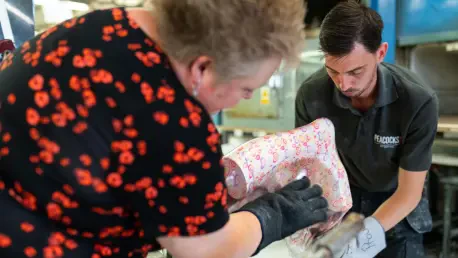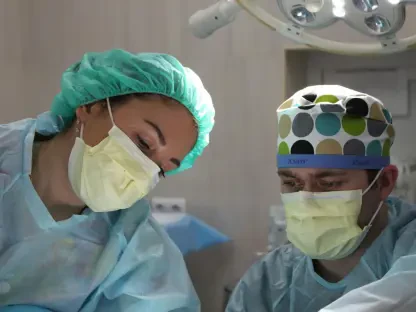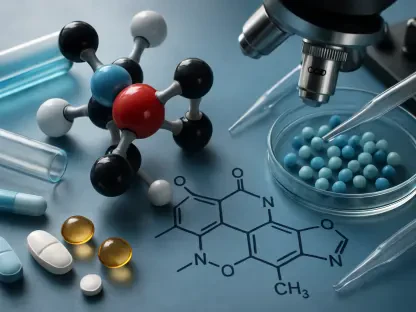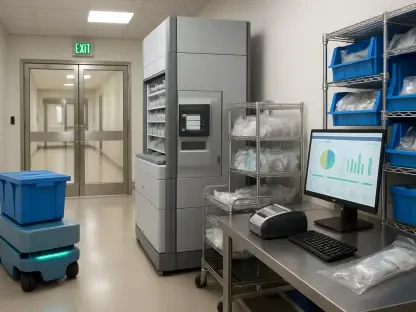In an era where environmental consciousness and sustainability are at the forefront of global agendas, the healthcare sector finds itself in a unique and pressing position. Hospitals and health systems are becoming increasingly aware of their significant role in contributing to greenhouse gas (GHG) emissions, which pose a substantial threat to global health. This realization has led to an urgent call for healthcare facilities to implement more sustainable practices, including the adoption of reprocessed medical devices. Notably, the healthcare industry is responsible for a significant portion of GHG emissions worldwide, and within the United States, it holds responsibility for a staggering 8.5 percent. This article explores the potential benefits and challenges of embracing reprocessed medical devices, such as single-use devices (SUDs), to address this substantial environmental impact.
Focus on Healthcare Sector Emissions
Understanding Scope 3 Emissions and Their Impact
The healthcare sector’s environmental footprint extends beyond its immediate operations, with a significant portion of emissions stemming from Scope 3 activities. These are emissions associated with the supply chain, encompassing everything from the production to the disposal of medical devices and supplies. Scope 3 emissions account for approximately 82 percent of the sector’s total emissions, with single-use medical and surgical devices being key contributors due to their high-energy consumption in manufacturing and their tendency to generate considerable waste. Operating rooms, in particular, are major culprits, consuming up to six times the energy of other hospital areas and accounting for more than half of a hospital’s waste. Hospitals often face challenges in managing these emissions effectively, as they stem from sources outside their direct control.
To tackle these emissions, healthcare institutions are increasingly looking at ambitious targets, such as reducing their GHG emissions by 50 percent by 2030 and striving for net-zero emissions by 2050. These goals align with broader global environmental objectives and underscore the importance of adopting more sustainable practices. By focusing efforts on high-impact areas like operating rooms and the devices they use, hospitals can make significant strides toward these targets. Reducing the environmental impact of medical device usage, particularly SUDs, becomes an essential strategy, necessitating innovative solutions for emissions management.
Reprocessing single-use medical devices emerges as a viable option to mitigate the environmental footprint of the healthcare sector without compromising patient safety. The practice involves cleaning, testing, and repackaging devices for safe reuse, which can substantially reduce energy use and waste production, while maintaining stringent safety standards set by bodies such as the FDA. Embracing reprocessed medical devices enables healthcare institutions to cut down their supply chain emissions directly and indirectly by influencing the broader supply chain towards sustainable practices.
The Promising Future of Reprocessed Single-Use Devices
Reprocessed single-use devices (rSUDs) have gained attention as an effective means to lower both carbon emissions and financial costs. These devices are subject to rigorous oversight by the FDA to ensure their safety and effectiveness when reintroduced into medical settings. Prominent studies dating back to the late 1990s have consistently indicated that reprocessed devices do not pose an increased risk to patient safety. As a result, the medical community and regulatory agencies now recognize rSUDs as a legitimate and reliable alternative to new devices.
The economic benefits of adopting rSUDs are significant. In the previous year alone, the deployment of these devices enabled U.S. hospitals to save over $398 million, while preventing the release of around 113 million pounds of CO2 equivalent emissions. This reduction is equivalent to eliminating the usage of approximately 5.79 million gallons of gasoline, highlighting the considerable impact reprocessing can have on a hospital’s carbon footprint. However, despite these advantages, the integration of rSUDs into hospital practices has been limited, partly due to lingering misconceptions regarding their safety and efficacy.
Importantly, life cycle assessments comparing rSUDs to their newly manufactured counterparts reveal substantial environmental benefits, with rSUDs offering a 40 to 60 percent reduction in GHG emissions. Such assessments have found an average carbon equivalent reduction of 44 percent when using reprocessed devices. The data makes a compelling case for more widespread adoption. As hospitals and health systems become more acquainted with the tangible environmental and financial advantages of reprocessing, there is potential for change at both institutional and industry levels.
Challenges to Integration
Overcoming Misunderstandings and Resistance
One of the main barriers to the wider adoption of reprocessed medical devices is the persistent misunderstanding regarding their safety and reliability. Despite overwhelming evidence supporting their efficacy and endorsement by regulatory bodies such as the FDA, some healthcare professionals harbor doubts that prevent widespread acceptance. These misconceptions are often perpetuated by original equipment manufacturers (OEMs) who have vested interests in selling new devices rather than promoting reprocessing. OEMs have been known to engage in practices that inhibit reprocessing efforts, such as altering device designs to make them non-reusable or updating software to disable reprocessing capabilities.
The resistance from OEMs presents a significant hurdle for hospitals interested in sustainable procurement strategies. By monopolizing control over device design and pricing structures, OEMs limit the scope and scale of reprocessing programs. For example, some manufacturers have been found to inflate the prices of devices that could be reprocessed, thereby disincentivizing hospitals from pursuing greener alternatives. To counter these challenges, there is a growing consensus that federal interventions might be necessary to address anti-competitive practices and promote fair competition in the medical device market.
Education plays a crucial role in dispelling myths and increasing the adoption of rSUDs. Comprehensive educational campaigns can inform healthcare staff and stakeholders about the benefits and safety of reprocessing, facilitating a cultural shift towards embracing sustainable practices. Such efforts can also empower hospitals to negotiate more favorable terms with OEMs and foster collaboration across the supply chain, enhancing the effectiveness of reprocessing initiatives.
Opportunities for Policy and Practice Improvement
Despite the challenges posed by misconceptions and market dynamics, numerous opportunities exist to bolster the integration of reprocessed medical devices within healthcare systems. Key among these is the development and implementation of procurement policies that prioritize sustainability. By enacting guidelines favoring reprocessed devices when possible, healthcare leaders can drive demand for sustainable options, encouraging further innovation and collaboration across the industry.
Government interventions and incentives can also play a pivotal role in promoting the adoption of rSUDs. Policy measures that reward sustainable practices, whether through tax incentives, grants, or subsidies, can have substantial influence on institutional behavior. Such incentives could motivate healthcare providers to prioritize reprocessing as a core component of their environmental sustainability strategies, aligning economic interests with ecological responsibility.
Furthermore, the healthcare sector stands to benefit from international examples that illustrate effective strategies for integrating sustainability into healthcare practices. The United Kingdom’s National Health Service (NHS), for instance, has been at the forefront of reducing reliance on single-use devices through initiatives like the “Design for Life” roadmap. By fostering a circular economy approach and decreasing foreign dependencies, the NHS provides a valuable framework for other healthcare systems striving to enhance their sustainability profiles. Emulating these comprehensive strategies could significantly amplify the positive impact of reprocessed medical devices.
Charting a Sustainable Future
Advantages of Dual-Purpose Sustainability Initiatives
Reprocessing single-use devices not only serves environmental objectives but also aligns with healthcare facilities’ financial goals. By minimizing procurement and waste disposal costs, hospitals can achieve substantial savings that enhance overall operational efficiency. The resilience acquired through sustainable practices also acts as a safeguard against potential disruptions, such as international tariffs on medical devices. This added financial stability positions healthcare systems to effectively manage fluctuations in the global supply chain while maintaining quality care.
Moreover, rSUDs emerge as an accessible strategy for immediate implementation, demonstrating that eco-friendly options can be financially advantageous. By debunking the myth that sustainable choices are inherently costlier, the healthcare sector can achieve concurrent improvements in its economic and ecological standing. This alignment of financial and environmental interests helps redefine the perception of sustainability initiatives as strategic investments rather than mere expenses.
Healthcare entities can further realize these benefits by adopting robust policies that support reprocessing and advocate for continued innovations in device manufacturing and supply chain optimization. By cultivating a culture of sustainability, healthcare leaders can champion both fiscal responsibility and ecological stewardship. Such leadership is crucial to catalyzing industry-wide transitions toward environmentally harmonious practices that foster long-term resilience and success.
Recommendations for Progress and Implementation
To capitalize on the advantages of reprocessed medical devices and surmount existing barriers, strategic recommendations are essential. Continuous education for healthcare staff and stakeholders on the safety and benefits of reprocessing is vital to increasing acceptance and integration. Healthcare systems should allocate resources to training programs that highlight successful case studies and provide practical guidance on implementing reprocessing initiatives.
Furthermore, federal investigations into the anti-competitive practices of OEMs could address systemic obstacles and promote fair market opportunities. By fostering transparency and accountability, these investigations could generate industry-wide momentum towards embracing sustainable innovations that drive positive change.
Leadership from healthcare executives and policymakers is also imperative. By prioritizing sustainability in procurement practices and advocating for government-backed incentives, these leaders can reinforce the commitment to both environmental and economic objectives. Such actions lay the foundation for a more sustainable healthcare sector that actively contributes to global efforts to combat climate change.
Conclusion: A Commitment to Change
The healthcare sector’s environmental impact extends notably beyond immediate operations, with a substantial part of its emissions stemming from Scope 3 activities. These encompass the entire supply chain, from the production of medical devices and supplies to their eventual disposal. Astoundingly, about 82% of all emissions in this sector originate from Scope 3 activities. This is particularly true for single-use medical and surgical devices, which not only consume a large amount of energy during manufacturing but also create significant waste. Operating rooms are particularly energy-intensive, consuming up to six times more energy than other hospital areas and generating over half of a hospital’s waste. Hospitals often find managing these emissions challenging since many sources are outside their direct control.
In response, healthcare institutions are targeting a reduction in greenhouse gas emissions by 50% by 2030 and aspire to achieve net-zero emissions by 2050. These ambitious goals reflect the broader global push for sustainability and underscore the importance of adopting greener practices. Targeting high-impact areas like operating rooms and the devices they use offers a meaningful path toward reducing emissions. Consequently, reprocessing single-use devices has emerged as a promising solution. This practice involves thoroughly cleaning, testing, and repackaging for safe reuse, aligning with safety standards enforced by authorities like the FDA. Not only does this reduce energy consumption and waste, but it also leads to lower supply chain emissions and encourages sustainable practices sector-wide.









